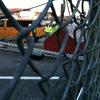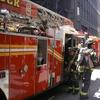Janet Babin appears in the following:
Program Boosting Graduation Rates for Low-Income CUNY Students: Study
Wednesday, June 13, 2012

A City University of New York program designed to improve the notoriously low graduation rates of low-income community college students appears to be working, according to preliminary results of an independent study.
Pushing Back Against Critics, NYU Powers Ahead With Expansion Plan
Tuesday, June 05, 2012

Town and gown disputes between Greenwich Village and the sprawling university date back to the 1800s. But now increasingly NYU faculty and staff are joining with residents to oppose the school’s plan.
1 World Trade Center Could Fall Short of America's ‘Tallest’ Status
Friday, May 11, 2012

One World Trade Center is New York City’s tallest building, but a design change could jeopardize its anticipated distinction as America’s tallest building.
NYC, 44 Other Regions, Blow 2008 Smog Standards
Wednesday, May 02, 2012
(photo by: harry_nl)
(New York -- WNYC) New York City and surrounding suburbs currently blow past smog limits set by the U.S. Environmental Protection Agency.
The agency’s latest data, released Tuesday, found that forty-five areas of the country fail to meet air quality standards for ground level ozone.
The standards were set by the Bush Administration in 2008. They allow 75 parts of smog per billion cubic feet of air. As you can see on the map below, pockets of the country in almost all regions fail to meet air quality standards, but the bulk of "nonattainment" areas are along the Northeast corridor and throughout California. (See the EPA's designations for each area here.)
The agency said that the noncompliant areas were assigned a classification based on how close they are to meeting the standards. The classifications range from marginal to moderate, serious, severe and extreme. Most of the areas that do not meet the standards, including the New York region, are classified as marginal – that is, closest to meeting the standards.
The EPA said it expects these areas would be able to comply within three years, usually as a result of recent and pending federal pollution control measures.
“The standards are too weak,” said Frank O'Donnell, president of the DC-based non-profit environmental group Clean Air Watch. O’Donnell is pushing for the EPA to move ahead with low-sulfur gasoline. “Now that gasoline prices are dropping, we urge the House Energy and Commerce Committee to drop plans to kneecap EPA authority to see cleaner gas standards,” said O’Donnell.
New York City Mayor Michael Bloomberg’s office said in a statement that the city has made progress on cleaner air... cutting greenhouse gasses by 12 percent below 2005 levels.
In an email, an EPA spokeswoman said it was a “coincidence” that the data was released on May 1st, World Asthma Day. Smog can reduce lung function and aggravate asthma.
NYC Region Exceeds Smog Standards: EPA
Wednesday, May 02, 2012
New York City and its surrounding suburbs exceed smog limits set by the U.S. Environmental Protection Agency — but not by much.
Searching for the First Milk Carton Boy, Etan Patz
Friday, April 20, 2012
Most NYU Professors Oppose Expansion Plan: Survey
Wednesday, April 18, 2012

Most New York University professors oppose the university’s downtown expansion plan, according to a new survey.
LaGuardia, JFK Airports improve On-Time Departures; Newark Last
Thursday, April 12, 2012
(photo by Alex Goldmark)
Air travelers in the New York area who want to improve their chances of leaving on time might want to fly out of LaGuardia. The airport posted big gains in on-time departure statistics over last year, while JFK International Airport only improved somewhat, and Newark International landed on the bottom.
LaGuardia ranks 6th among the nation's 29 major airports in on-time departures so far this year, according to statistics released today from the U.S. Department of Transportation. That compares to January - February 2011, when LaGuardia ranked a lowly 23rd in on-time departures.
JFK International Airport did see some improvement, but the change was not as dramatic as at LaGuardia. JFK ranked near the bottom of the list in on-time departures last year; so far this year the airport ranks 12th when compared to the nation’s 29 major airports.
Last year’s January blizzard in New York, along with record setting snowfall levels in the region last winter, may have been a factor in LaGuardia’s improved departure performance this year. But if weather were the only factor, similar gains would have likely been seen at JFK and Newark. And that was not the case.
And weather can’t account for Newark International Airport’s on-time departure record; it’s even worse than last year, despite the mild weather. The airport ranked last among the nation’s biggest airports so far this year for on-time departures. In January and February of 2011, it ranked 27th.
The data also ranks the on-time arrival rate of major airlines. Virgin America topped that list; it had the highest on-time arrival rate of the 15 airlines that file statistics with the Bureau of Transportation; while United Airlines had the lowest.
NYU Downsizes Expansion Plans
Tuesday, April 10, 2012
New York University has agreed to scale back massive downtown expansion plan, following requests from Manhattan Borough President Scott Stringer.
Port Authority Awaits Fed Decision on Bayonne Bridge Project
Sunday, April 08, 2012

Port Authority officials are waiting to find out whether the federal government will allow a project involving the Bayonne Bridge to move through a faster permit process.
Crane Co. Involved in Deadly Accident Cited Previously, MTA Suspends Work at Site Indefinitely
Friday, April 06, 2012
The contractor hired by the MTA to operate the crane that collapsed Tuesday was hired after it submitted the lowest bid for the job. Yonkers Contracting Company is a large firm that's worked on a number of public works projects, like the World Trade Center site. But it also was fined by Occupational Safety and Heath Administration for safety violations at least four times in the last decade.
Bus Protocol: A Work In Progress
Friday, April 06, 2012

Work at Crane Collapse Site to Resume Monday
Thursday, April 05, 2012
West Side Crane Collapse. Image by: B. Zumhagen
Work at the site of the crane collapse that killed one man Tuesday will resume on Monday, according to the MTA. Investigations into what caused pieces of the crane to snap off continue, led by the New York City Department of Buildings and OSHA.
The incident happened Tuesday evening at 34th Street between 10th and 11th Avenues, the area where the MTA is extending the Number 7 Subway Line.
Meanwhile, the City Council and the MTA continue to be at odds over who should have oversight of the Number 7 Train extension site, and other MTA construction sites.
As a state agency, the MTA is exempt from city safety laws.
East Side City Council Member Jessica Lappin was one of the people directly responsible for making city crane safety rules tougher after a total of nine people died in crane collapses in 2008. Lappin, along with Council Speaker Christine Quinn, continues to push for the MTA to adhere to city construction safety rules.
“I do think the MTA should stop pointing fingers and should follow the rules that we have already set out,” Lappin said.
The MTA said it has the same goal as the city, that is, safety. "The MTA like all other state agencies has to follow state codes. We try to keep our sites as safe as possible," said Adam Lisberg, the director of External Communications for the MTA.
After the 2008 incidents, Lappin sponsored and the council passed four bills that strengthen crane safety rules. One requires crane operators to undergo a thirty hour safety and training course, with an eight hour refresher course every three years.
Another new law makes engineers create site safety plans before cranes are used at a construction site.
A third bill prohibits nylon slings, which were found to be the cause of the March 2008 crane collapse.
The laws also give the city ability to put a compliance safety officer on the ground at construction site where repeated safety problems occur with a particular contractor.
There wasn’t a city compliance safety officer at the 34th street site because the MTA is exempt from these bills, emphasized Councilwoman Lappin. "That’s really the whole issue here," she said.
The councilwoman and the MTA said they continued to talk Thursday about adhering to city safety standards on MTA work sites.
The agency ordered inspections Wednesday of all MTA construction cranes.
There are ten cranes on the Number 7 Subway extension site, including the one that collapsed. The MTA reported that all of them were operating with valid permits from NYC Department of Buildings. The other nine all passed the new round of inspections. Fourteen cranes on the MTA’s East Side Access Construction site all checked out with valid certifications. The MTA said all were re-inspected before being used on Thursday.
Additionally, the MTA said safety briefings were held before the start of every shift. At the Fulton Street Transit Center, there is one 45-ton crane that had no reported problems on reinspection.
The other major MTA construction site, the massive Second Ave Subway project, did have one crane with an "illegible" certificate. But the MTA said it has no reason to believe the certification is expired.
Defects Found in Collapsed Crane That Killed Worker
Thursday, April 05, 2012

Engineers have found defects in the hoisting system of the construction crane that crashed down at a Manhattan worksite, killing a worker, according to the New York City Department of Buildings.
NYC and MTA Trade Shots Over Ownership of Crane Collapse Site
Thursday, April 05, 2012
UPDATED New York City and the NY MTA are trading shots over who owns the site of a crane collapse that killed one worker and injured four others on Tuesday.
Council Speaker Christine Quinn, a likely 2013 mayoral candidate, said that the site is controlled by the MTA right now, and that means that State rules — not city construction regulations, apply.
“Right now, since it is an MTA work site, city agencies have to be invited…on site as opposed to every other work site in the city of New York,”
But the MTA shot back with a statement of its own.
"Crane contractors working on MTA construction projects are required to obtain annual operating certificates from the NYC Department of Buildings, and to post their current inspection certifications on the crane. The site of yesterday’s incident is city-owned property, which also gives the NYC Department of Buildings jurisdiction to inspect cranes there. The two attached documents show the reports from the two most recent NYC Department of Buildings inspections of the Yonkers Contracting Company Inc. crane in operation during yesterday’s incident."
In July, the MTA says, the the NYC Department of Buildings performed an annual inspection of the crane. Its written report indicated “No Deficiencies” at the top of the first page, and finished with the conclusion “No deficiencies found on crane at time of inspection.”
A second inspection, scheduled for January, was rescheduled because the crane was in operation. It was rescheduled -- for today.
After we initially posted this story, MTA spokesman Adam Lisberg emailed us a note downplaying the dispute: "The city and the MTA are not feuding over who owns the property," Lisberg wrote. " City Council Speaker Christine Quinn wants to change the law regarding oversight of construction; we believe it's an idea worthy of study."
But the controversy is the latest wrinkle in the complications caused by the fact that the state runs the authority, which is largely associated with the city. But the legislature -- with a large upstate representation often hostile to the city -- controls the budget. And the board is appointed mostly by the governor, who doesn't always see eye-to-eye with the mayor on policy.
The MTA has suspended all work at the site until further notice. It has also ordered the inspection of all cranes at MTA construction sites in the city.
A variety of agencies, including the police department and the Manhattan district attorney, are investigating the cause of the collapse.
The MTA said Yonkers Contracting Company owned and operated the crane. According to the Occupational Health and Safety Administration, the company was fined four times — three of those violations were classified as serious. In 2010, the firm was fined $3,000 for a lack of adequate worker training.
Calls placed to the company for comment were not immediately returned.
Michael Simmermeyer, 30, of Burlington, N.J. was pronounced dead following Tuesday's accident at the No. 7 subway line extension construction site at 34th Street and 11th Avenue. One other person was hospitalized in serious condition and three people were treated for minor injuries.
Simmermeyer worked at the site with his father, his co-workers said.
"Both great guys to work with and hang out with. It's just horrible," said Joe Travers, an ironworker from the Rockaways. Simmermeyer was "one of the nicest guys I've ever worked with," he said.
Mayor Michael Bloomberg said the city has made crane safety and construction reforms in the wake of the May 2008 East Side crane collapse that killed a crane operator and fellow worker. The crane's owner is currently on trial for manslaughter.
"We've made aggressive reforms to construction safety and crane safety," Bloomberg said Wednesday.
The crane was set up on the second of three levels on the construction site on Manhattan's West Side, city officials said. The FDNY said the boom came apart in two pieces — one 80 feet long and the other 40 feet long.
Jack Sullivan, deputy chief for the FDNY EMS, said it was possible one of the workers had been struck by the crane's boom. The crane operator and someone who worked with him were among those who were injured.
He described the removal of the workers from the construction site, about 60 feet below street level, as "extremely dangerous."
"We had construction material that wasn't stable," he said.
Dozens of first responders came to the accident site.
Thomas Rushkin, a retired city police officer and private investigator, said he was on his way home when he saw emergency vehicles heading over and got a glance at the pieces of the crane.
"The arm is broken in half," he said, adding that it appeared that one part of the crane was on a level below the street.
The Metropolitan Transportation Authority released a statement saying they plan to work with all proper authorities to conduct a thorough investigation into the incident.
"On behalf of the entire MTA, we pray for the recovery of the workers injured as a result of this tragic accident," the statement said.
City, MTA Trade Shots as West Side Crane Collapse Probe Continues
Thursday, April 05, 2012
The city and the MTA are trading shots over who owns the site of a crane collapse that killed one worker and injured four others on Tuesday.
Bus Etiquette in New York? Ha!
Tuesday, April 03, 2012
For New Yorkers, all rules are just suggestions.
Exit at the rear of the bus? Fuggedaboutit!
“Please exit through the rear door,” quips the sonorous lady in the recorded messages that drone on over the din of noisy passengers. There's a reason for that -- it makes bus riding much faster for everyone. In some cities, you get a ticket for exiting at the front.
In New York?
Iris Holland was oblivious to the message as she exited from the front of the M15 bus onto Second Avenue the other day.
“I’m going for physical therapy, so instead of getting out at the end and having to walk, I sit near the front and get out at the front,” said Holland.
Pretty much no one listens to the admonitions. Which are there, of course, to make the buses move faster.
It's a bit better, but not much, on the city's select buses, where you don't have to wait for people to exit before you can get on and pay. But you have to buy a ticket, or get a receipt before you board, which causes no end of confusion, even -- or especially -- among seasoned New York bus riders.
The other day along New York City’s M34 bus route, a gaggle of would-be passengers queued up for an approaching cross-town ride. It was orderly enough; no pushing, shoving or angry glances to speak of.
But there was some confusion around the payment kiosk.
“How do you get a bus ticket?” asked Alice Sramkova, visiting from Prague, Czech Republic, with her two pre-teen daughters trailing behind her. And she wasn't the only one - several New Yorkers kept within ear shot hoping to hear an answer.
Searching for Answers on the M34 - Image by: Janet Babin, WNYC
Other passengers leaned in to offer advice. “This is your ticket,” said one, pointing to her Metro Card. “No, your receipt is your ticket,” clarified another. By now a circle of uninitiated passengers surrounded Sramkova. Many did not realize they had to pay before the bus stopped. “I guess we got on the bus twice without having a valid ticket,” smiled Sramkova.
So it is with the NYC MTA’s so called “Select” bus service – that is, buses designed to speed up designated routes. To get them to move faster, the MTA has initiated several changes, that include limited stops, paying before boarding the bus with a Metro card only, boarding via the front or the back doors, and dedicated bus lanes.
According to the MTA, the changes trim up to 20-% off of travel times.
And on the M34, that’s saying something. It may feel like whatever bus you’re on is the slowest, but in fact, the MTA found that the M34 was among the slowest in the city. The route also carries more than 33,000 riders a day.
Careening down 34th Street - Image by: Janet Babin, WNYC
Before Select buses, the average speed of any city bus was 4.5 miles per hour – that’s only a hair faster than walking. The MTA began speedier service along 34th Street in November 2011, but passengers are still getting used to it. The service was first offered on Fordham Road in the Bronx in 2008. Select buses also run up First and down Second Avenues, on the M15 line.
Even though they’ve been around longer than the 34th Street Select Buses, there were still some blank stares and misunderstandings as passengers tried to board a Select Bus at 14th Street and Second Avenue last week.
Paying off board the M34 - Image by: Janet Babin, WNYC
Paying off board does not seem to come naturally to many passengers. “I don’t see what the big deal is to use your Metro Card and get on the bus; it’s a waste,” said rider Joan Marks.
The MTA said the purpose of paying off board is to save time of course. Think how long it takes to swipe all those Metro Cards as people enter the front of the bus, and then there are those who pay the $2.25 fare with coins, taking even longer. All that time people are paying, your bus is going nowhere.
Since bus drivers don’t check receipts, it is tempting to hop on board and ride for free. But that could turn out to be one expensive ride. Anyone caught without one of those receipts could face a $100 fine. And the MTA refused to say how many, but emphasized that bus inspectors are still riding the Select buses, searching for scofflaws.
Still, the MTA said fare evasion is receding. Fines have dropped by more than a third from their peak in June 2011, when the MTA issued 1067 summonses for fare evasion.
Bus drivers who notice riders flashing Metro Cards their way will often tell riders to get off the bus. That’s what happened to Mona and Osama Salih when they boarded an M15 bus last week without the required proof of payment receipt. Both showed the driver their Metro cards, thinking that’s all they had to do.
“The bus driver said you have to pay off the bus and then he left,” said Mona. She could not believe he didn’t wait. “Why has a Metro card if you have to have a receipt,” added Osama.
When riders don’t know the drill, some bus drivers will leave them behind. But not always.
“There’s a lot of tourists,” said bus driver Al Thomas. He said he will almost always explain how they are supposed to pay, but will only wait for them to pay if he is not holding up all the other passengers. “Depending on the light, because if you wait for everybody, it defeats the purpose.”
Metro Card Ready? check! - Image by: Janet Babin, WNYC
The Salih’s boarded a second Select Bus minutes after the first one had left. And this time, they carried their crumpled receipts in their hands, just in case.
City Council Condemns Shooting Death of Trayvon Martin
Wednesday, March 28, 2012

More than a dozen City Council members sported hoodies at City Hall Wednesday, to show solidarity with the unarmed sweatshirt-clad Florida teen who was gunned down at the hands of a neighborhood watch captain.
City Firefighter Leaves Hospital After 3 Months
Friday, March 23, 2012
Brooklyn firefighter Robert Wiedmann is finally home after being badly injured in a Crown Heights blaze three months ago.





















